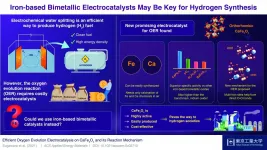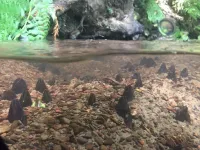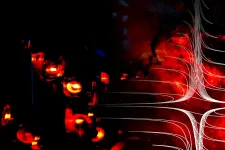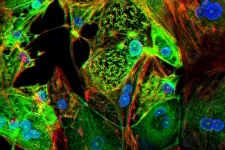(Press-News.org) EUGENE, Ore. - March 2, 2021 - High-resolution imaging and 3D computer modeling show that the dendrites of neurons weave through space in a way that balances their need to connect to other neurons with the costs of doing so.
The discovery, reported in Nature Scientific Reports Jan. 27, emerged as researchers sought to understand the fractal nature of neurons as part of a University of Oregon project to design fractal-shaped electrodes to connect with retinal neurons to address vision loss due to retinal diseases.
"The challenge in our research has been understanding how the neurons we want to target in the retina will connect to our electrodes," said Richard Taylor, a professor and head of the UO physics department. "Essentially, we have to fool the neurons into thinking that the electrode is another neuron by making the two have the same fractal character."
Working with collaborators at the University of Auckland and University of Canterbury in New Zealand, confocal microscopy of neurons in the hippocampal region of a rat's brain revealed an intricate interplay of branches weaving through space at multiple size scales before connecting to other neurons. That, Taylor said, raised the question, why adopt such a complicated pattern?
With the help of UO post-doctoral researcher Saba Moslehi, doctoral students Julian H. Smith and Conor Rowland turned to 3D modeling to explore what happens when they manipulated the dendrites of more than 1,600 neurons into unnatural forms, straightening them or curling them up.
"By distorting their branches and looking at what happens, we were able to show that the fractal weaving of the natural branches is balancing the ability of neurons to connect with their neighbors to form natural electric circuits while balancing the construction and operating costs of the circuits," Rowland said.
Using a fractal analysis known as the box-counting technique, the researchers were able to assign fractal dimensions, or D values, that quantify the relative contributions of the coarse- and fine-scaled dendrites to a neuron's fractal pattern. These D values, Taylor said, will be important in optimizing his team's tiny electrodes for implanting at the back of eyes to stimulate retinal neurons.
"Our implants will have to accommodate the neurons' weaving branches through careful selection of their D values," said Taylor, a member of the UO's Materials Science Institute. "Unlike building a straight runway so a pilot can land efficiently, our electrodes will need to act like a weaving runway so that the neurons can connect without changing their behavior."
Nature's fractals benefit from how they grow at multiple scales, said Taylor, who has long turned to fractals as bioinspiration. While trees have the most-recognized form of fractal branching, this work, he said, highlights how neurons are different from trees.
"Whereas the fractal character of trees originates predominantly from the distribution of branch sizes, the neurons also use the way their branches weave through space to generate their fractal character," Taylor said.
Taylor, a Cottrell Scholar of the Research Council for Science Advancement, was granted a sweeping U.S. patent in 2015 for not only his development of artificial fractal-based implants related to vision but also to all such implants that link signaling activity with nerves for any purpose in animal and human biology.
Taylor and co-authors closed their paper by raising the possibility that the D values of neuronal networking may benefit research on numerous brain-related diseases. For Alzheimer's disease, Taylor said, D values could be a measure for understanding declines in connectivity between neurons.
"A lot of diseases result in losing connectivity, and neuron D values may be dropping as they move into a pathological state," he said.
INFORMATION:
Additional UO co-authors on the paper were doctoral students Rick D. Montgomery, Kris Schobert and William Watterson. Other co-authors were Bruce Harland, a research fellow at the University of Auckland, and John Dalrymple-Alford, a neuroscientist at the University of Canterbury.
The W.M. Keck Foundation, Living Legacy Foundation and Ciminelli Foundation funded the research.
Links:
About Richard Taylor: https://blogs.uoregon.edu/richardtaylor/
UO Department of Physics: https://physics.uoregon.edu/
UO Materials Science Institute: https://materialscience.uoregon.edu/
Simulations say bio-inspired retinal implants should work:
https://around.uoregon.edu/content/simulations-say-bio-inspired-retinal-implants-should-work
Regenerating Vision: https://around.uoregon.edu/oq/regenerating-vision
An analysis of law enforcement seizures of illegal drugs in five key regions of the United States revealed a rise in methamphetamine and marijuana (cannabis) confiscations during the COVID-19 pandemic. Seizures of the two drugs were higher at their peak in August 2020 than at any time in the year prior to the pandemic. While investigators found that trends in heroin, cocaine and fentanyl seizures were not affected by the pandemic, provisional overdose death data show that the increased drug mortality seen in 2019 rose further through the first half of 2020.
The findings suggest that the pandemic and its related restrictions may ...
Washington, DC-- March 2, 2021 -- Detecting COVID-19 outbreaks before they spread could help contain the virus and curb new cases within a community. This week in mSystems, an open-access Journal of the American Society for Microbiology, researchers from the University of California San Diego describe a mostly-automated early alert system that uses high-throughput analysis of wastewater samples to identify buildings where new COVID-19 cases have emerged--even before infected people develop symptoms.
The approach is fast, cost-effective, and sensitive enough to detect a single ...
Today, we can say without a shadow of doubt that an alternative to fossil fuels is needed. Fossil fuels are not only non-renewable sources of energy but also among the leading causes of global warming and air pollution. Thus, many scientists worldwide have their hopes placed on what they regard as the fuel of tomorrow: hydrogen (H2). Although H2 is a clean fuel with incredibly high energy density, efficiently generating large amounts of it remains a difficult technical challenge.
Water splitting--the breaking of water molecules--is among the most explored methods to produce H2. While there are many ways ...
Pesticides used in forestry may threaten species in downstream rivers and estuaries, but little is known about the extent to which this occurs. A new study by researchers at Portland State University found mussels, clams and oysters in watersheds along the Oregon Coast are exposed to pesticides used in managing forests. The results of this study, published in the journal Toxics, have implications for developing better forest management practices that are less likely to negatively affect aquatic life.
The study was led by Kaegan Scully-Engelmeyer, PhD student in the Earth, Environment and Society program at Portland ...
The coronavirus pandemic has drawn new attention to the digital divide, as the need for online schooling and working from home has disproportionately hurt those without computer equipment and skills.
Research by Paul A. Pavlou, dean of the C. T. Bauer College of Business at the University of Houston, found that people with basic Information Technology (IT) skills - including the ability to use email, copy and paste files and work with an Excel spreadsheet - are more likely to be employed, even in jobs that aren't explicitly tied to those skills.
People with more advanced IT skills generally earned higher salaries, the researchers found. The work is described in Information Systems Research.
"Unemployment and low wages remain pressing societal challenges in the wake of increased ...
A new study has shown that gentle streams of water carrying sound and microscopic air bubbles can clean bacteria from salad leaves more effectively than current washing methods used by suppliers and consumers. As well as reducing food poisoning, the findings could reduce food waste and have implications for the growing threat of anti-microbial resistance.
Salad and leafy green vegetables may be contaminated with harmful bacteria during growing, harvesting, preparation and retail leading to outbreaks of food poisoning which may be fatal in vulnerable groups.
Because there is no cooking process to ...
Healthcare sex discrimination protections for the LGBTQ community may be expanded under the Biden Administration, including safeguards against verbal abuse, physical abuse and the denial of bedside care, according to West Virginia University College of Law experts.
In a report published in California Law Review, Professor Valarie Blake and students Ashley Stephens and Amy Post examined whether gender identity and sexual orientation should be included in healthcare sex discrimination laws, on the heels of the historic 2020 Supreme Court case Bostock v. Clayton County.
In that case, the Court ruled that sex discrimination includes gender identity and sexual orientation when it comes to employment standards. Yet the interpretation of whether ...
Scientists at the University of Bath in the UK have found a way to bind together two photons of different colours, paving the way for important advancements in quantum-electrodynamics - the field of science that describes how light and matter interact. In time, the team's findings are likely to impact developments in optical and quantum communication, and precision measurements of frequency, time and distances.
APPLE AND WAVE: THEY BOTH HAVE A MASS
An apple falling from a tree has velocity and mass, which together give it momentum. 'Apple energy' derived from motion depends on the fruit's momentum and mass.
Most people find ...
Volcanic basalt rocks in the Black Rock Desert, Utah.
If you drive south through central Utah on Interstate 15 and look west somewhere around Fillmore, you'll see smooth hills and fields of black rock. The area is, aptly, named the Black Rock Desert. It may not look like much, but you're looking at some of Utah's volcanoes.
A pair of earthquake sequences, in September 2018 and April 2019, focused scientists' attention on the Black Rock Desert. The sequences, which included the main quakes and their aftershocks, were very different from the Magna earthquake that shook the Wasatch Front in 2020 and other Utah earthquakes. The Black Rock sequences were captured ...
Since early in the pandemic, COVID-19 has been associated with heart problems, including reduced ability to pump blood and abnormal heart rhythms. But it's been an open question whether these problems are caused by the virus infecting the heart, or an inflammatory response to viral infection elsewhere in the body. Such details have implications for understanding how best to treat coronavirus infections that affect the heart.
A new study from Washington University School of Medicine in St. Louis provides evidence that COVID-19 patients' heart damage ...







